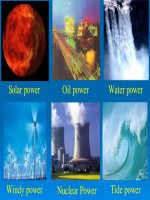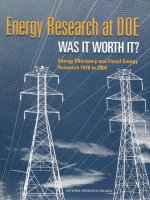Energy evolution
Bạn đang xem bản rút gọn của tài liệu. Xem và tải ngay bản đầy đủ của tài liệu tại đây (73.61 KB, 7 trang )
Evolution of Energy Sources
The economic and technological development of societies is linked with shifts in sources of energy.
The tendency has been the adoption of denser energy sources, as the shift from coal (solid) to oil
(liquid) and natural gas (gas) indicates. This shift can be simplified into 5 major phases, one being
speculative:
• From the beginning of history up to the industrial revolution (18th century), mankind's use
of energy relied only on muscular and biomass sources. Most work was provided by
manual labor and animals, while the biomass (mainly wood) provided for heating and
cooking energy needs. Other sources of energy, such as windmills and watermills were
present but their overall contribution was marginal.
• By the mid 19th century, the industrial revolution brought a major shift in energy sources
with the usage of coal, mainly for steam engines, but increasingly for power plants.
• As the 20th century began, the major reliance was on coal, but a gradual shift towards
higher energy content sources like oil began. This second major shift inaugurated the era
of the internal combustion engine and of oil-powered ships.
• In the late 20th century, the emphasis on petroleum products as the main provider of
energy reached the point where the world economy highly depends on the internal
combustion engine and supporting industries. As its level of technical expertise increased,
mankind was able to tap on more efficient sources of fossil fuels, mainly natural gas, and
energy released by matter itself (nuclear fission).
• The 21st century will be characterized by major shifts in energy sources with a gradual
obsolescence of polluting fossil fuels, like coal and oil, for more efficient fossil fuels such as
natural gas (although there may be substantial clean coal technology potential). Advances
in biotechnologies let anticipate the growing usage of biofuels. Nuclear energy, if nuclear
fusion becomes commercially possible, may also play a significant role. A very important
change in energy sources is likely to be the usage of hydrogen, mainly for fuel cells
powering vehicles, small energy generators and numerous portable devices.
HISTORY OF ENERGY
James C. Williams, Ph.D.
April 25, 2006
Energy plays a fundamental role in shaping the human condition. People's need for energy is
essential for survival, so it is not surprising that energy production and consumption are some of
the most important activities of human life. Indeed, it has been argued that energy is the key "to the
advance of civilization," that the evolution of human societies is dependent on the conversion of
energy for human use.
1
Few people have questioned the long-held assumption that standard of
living and quality of civilization are proportional to the quantity of energy a society uses. However
imprecise it may be, most people still accept the steadfast formula: energy=progress=civilization.
The widespread belief that energy and civilization are inextricably linked certainly has historical
foundation. Throughout history, humans have focused on controlling the energy stores and flows
that are part of nature. For tens of thousands of years, people relied solely on the chemical (caloric)
energy gained from food that produced the mechanical (kinetic) energy of working muscles. But
thanks to human intellect, people were able to unlock and overcome physical limits imposed on
their own muscle power "by using tools and harnessing the energies outside their own bodies."
The earliest "energy tools" were those used to hunt animals, harvest edible plants, catch fish and
fowl, and process and transport foodstuffs. Most of the family structures, societal groupings, and
political and economic institutions created over thousands of years focused primarily on the
extraction, processing, exchange, and marketing of food, as well as of "fossil and organic energy
sources (wood, peat, coal) ... used ... for heating, cooking, lighting, or for firing the kilns and
furnaces used in smelting ores." The vast array of unique human cultures absorbed the quest for
these basic energy resources into the widest range of human activities—rituals, festivals, taboos,
myth, dance, games, religion, language, art, and warfare—all of which embody humanity's cultural
values in their most fundamental forms. Quite simply, human existence has been dominated by the
age-old necessity for energy.
Age of Water Power
Before the modern era, people relied for power on their own muscles, on the muscles of
domesticated animals, such as horses and oxen, and on water and wind. People used these
energy resources to create a variety of significant landscapes, from agricultural fields and grazing
land to mining centers and commercial woodlots, and they built the towns and cities and
transportation networks of ancient civilizations. The technologies that relied on these energy
resources are familiar to us all: axes, picks, plows, harnesses, wagons and carriages, waterwheels,
windmills, and sailing ships.
Europe, which possessed many areas of water-power potential, particularly benefited from
harnessing the energy produced by moving water. The vertical waterwheel, invented perhaps two
centuries before the time of Christ, spread across Europe within a few hundred years. By the end of
the Roman era, waterwheels powered mills to crush grain, full cloth, tan leather, smelt and shape
iron, saw wood, and carry out a variety of other early industrial processes. Productivity increased,
dependence on human and animal muscle power gradually declined, and locations with good
water-power resources became centers of economic and industrial activity.
The historian Terry Reynolds observes: "Water power grew to be a central element in Western
technology."
6
During the Middle Ages, hydraulic engineers mounted mills on boats and bridges, and
from these evolved hydropower dams to store and develop water pressure and to divert water into
power canals and thence onto wheels. By the fifteenth century, large milling complexes in France
signaled the reality of industrial dependence on water power. The development of the camshaft and
crankshaft allowed water power to be applied to tasks that required a reciprocating motion (e.g.,
operating trip hammers and blast furnace bellows), which revolutionized the iron industry. The
number of watermills in Europe increased steadily. Larger and larger water-powered industrial
complexes emerged, culminating in large water-powered cotton mills operated during the 1770s by
William Strutt and Richard Arkwright in England.
Meanwhile, the harnessing of wind power to propel sailing ships across wide ocean expanses
opened up the Americas to Europe. Colonists brought with them water-powered mills, which
appeared from Latin America to Canada. By 1800, citizens of the newly established United States
were importing English style textile factories, and within two decades expansive water-powered
industrial cities emerged in Lowell, Massachusetts and other New England locations. By the time of
the Industrial Revolution, Euro-American industry depended for energy almost entirely on water
power.
Age of Steam
The modern era began with the eighteenth century introduction of steam power to English coal
mines by Thomas Savery and Thomas Newcomen. Their steam engines and those of James Watt
supplanted less geographically flexible water-powered mine pumps. Synergistic relationships
between coal mining, the iron industry, and steam power led to advances in steam technology, and
by 1800 steam engines joined waterwheels in powering English textile mills. Entrepreneurs found
that steam power overcame water power's geographic inflexibility, the limitation that any one
stream could only support so many mills, and waterwheel stoppages and slow downs caused by
drought, flooding, and ice. Although water power continued to be the dominant energy resource for
manufacturing through much of the nineteenth century, particularly in France and the United States,
steam power ultimately proved more flexible and economically efficient.
During the nineteenth century, steam engines improved enormously. American businessmen
imported steam power from England, and by the 1840s it began competing successfully with water-
powered manufactures. Philadelphia inventor Oliver Evans, famously known for automating water-
powered flour milling, patented one of the first successful high-pressure steam engines. His engine
and others modeled on it soon drove the riverboats and railroads that characterized America's
nineteenth century transportation revolution. In Philadelphia in 1876, an enormous iconic Corliss
steam engine towered over the main exhibition hall and powered the hundreds of machines on
display at the Centennial Exhibition.
7
The steam engine permanently established the link between fossil energy resources and
industrialization.
8
England and European countries turned to coal for steam fuel before 1800, and
by the mid-nineteenth century Appalachian coal succeeded wood as steam fuel in the eastern
United States. On the Pacific Coast, manufacturers and transporters continued to use wood, but
they preferred coal and imported it at great cost from as far away as Australia. The scarcity and
high cost of good coal on the Pacific Coast combined with discoveries of petroleum in southern
California resulted in the development of oil as steam fuel, which unseated coal as steam fuel
during the first half of the twentieth century.
9
The Electrical Age
Among the technological challenges in using inanimate energy resources is the transmission of
power. Toward the end of the eighteenth century, fascination with the phenomenon of electricity
captured many people.
10
The production of electricity with primary batteries and eventually with
electromagnetic induction, the transmission of electricity through copper wires, and the
development of electric motors ultimately revolutionized the transmission of power. By the end of
the nineteenth century, restrictive and inflexible direct connection of manufacturing machines to
waterwheels, windmills, and steam engines by gears, drive shafts, and belts gave way to
electrically powered machinery getting its power through wires strung from far away hydroelectric
and steam-turbine power plants. The shape and character of factories changed dramatically during
the twentieth century, as machines powered by electric motors could be sited almost anywhere.
11
Additionally, electric power supplanted horse-drawn and steam-powered street railways with the
electric "trolley," it replaced gas for outdoor lighting, and it replaced kerosene lights and wood and
coal stoves and heaters in homes.
12
Thomas Edison was especially important in the development of electricity. As noted in these
Franklin Institute case studies, "Edison's innovative approach to invention propelled the
development of the electric light plus the generation and distribution system to make it work." In the
1880s, his incandescent lamp made possible widespread, reliable, commercial indoor lighting, and
his Pearl Street central station generating system in Manhattan became the archetype for electric
power generation and distribution. Equally significant, Edison mentored a number of other
important contributors to electric power technology, among them Frank Sprague, who constructed
the first commercially successful electric street railway system in Richmond, Virginia in 1887, and
Nicola Tesla, who developed alternating current (AC) power generation.
Edison's direct current (DC) power system became the initial standard for distributed electricity,
powering electric railways and manufacturing motors as well as lighting. Unfortunately, it could not
be easily transmitted over long distances, which Tesla's AC power system achieved. Implemented
by Edison's competitor in electric power, the Westinghouse Company, AC power superseded DC
power and made possible the development of large electrical generating plants sited long distances
from customers. Although Westinghouse's harnessing of hydropower at Niagara Falls with Tesla's
polyphase system is perhaps better remembered, developments in AC power transmission from
distant Sierra Nevada power sites in California to the coastal cities of San Francisco and Los
Angeles established the standard in long-distance polyphase electric-power transmission.
13
By the early twentieth century, electricity had become the favored method for transmitting energy,
but applying it for human uses depended on many scientists and technicians working together.
Perhaps Edison's most important invention was the industrial research laboratory, and by the
beginning of the twentieth century, the General Electric Research Laboratory had emerged as a
model for advancing science and technology. There, researchers steadily improved the ways in
which humankind could apply electricity, and among them William Coolidge stood out. His
development of the tungsten filament for Edison's incandescent lamp and later the X-ray tube
earned him a most respected place in the ranks of twentieth century scientists and engineers.
The Nuclear Age
As electricity use became ubiquitous during the twentieth century, the exploitation of energy
resources increased enormously. Hydroelectricity continued to play an important role in the modern
energy matrix, but accessible water power sites were soon tapped. Engineers steadily improved
steam-turbine technology so that more electricity could be generated by smaller quantities of fuel.
As the size and efficiency of power plants increased, the cost of electric power dropped
dramatically, which stimulated even more consumption of electricity. Fossil fuels—first coal, then oil
—became the essential energy resources for electric-power generation.
Unfortunately, during the 1960s, increased efficiencies in electric-power generation leveled off, the
cost of electricity began to climb. Moreover, a growing environmental movement attributed acid raid
and other negative environmental impacts to the heavy use of fossil fuels. A search for an
alternative to fossil-fuel electric-power generation led many people to the atom.
Well back into the nineteenth century, research in physics had led to the discovery of nuclear
radiation. Most prominent in this discovery was Marie Curie, whose work "on the spontaneous
radiation emitted by uranium compounds" set the stage for subsequent discoveries on atomic
structure and the intrinsic power of the atom. The early decades of the twentieth century brought
sustained scientific research in atomic physics, particularly in Europe. Italian physicist Enrico Fermi
at the University of Rome was prominent among scientists working in this exciting field, and during
the 1930s he focused on producing artificial radiation by bombarding uranium atoms with neutrons.









